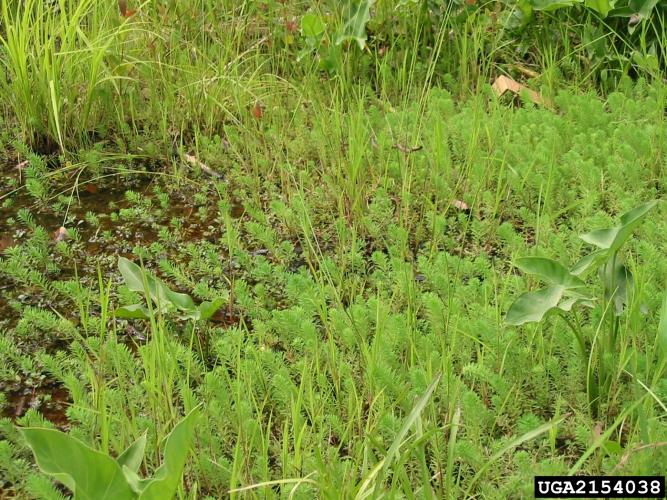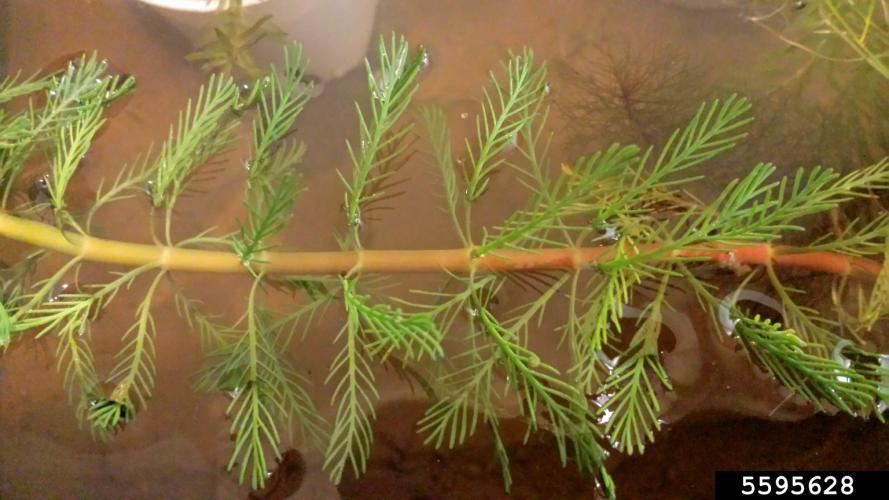Parrot feather
Identification
Appearance
Parrot feather is a submerged aquatic plant which produces a central stem and whorled leaves, directly attached to the stem. Parrot feather is heterophyllous, meaning that it displays different growth forms above and below water. Whorls of submerged leaves are further spread out along the stem than emergent whorls. Also, the submerged stem is reddish brown, while the emergent stem is bright green. Parrot feather grows mostly submerged, reaching up to 2m below water. Upon reaching the surface, the stem begins growing horizontally, and emergent stems begin growth, reaching 30cm above the surface.
Foliage
Parrot feather leaves grow in whorls of 4-6, directly off of the central stem. Leaves are pectinate (very deeply lobed with long, thin pinnae), with 12-18 lobes per side in emergent growth and 12-15 lobes per side in submerged growth. They resemble a pinnate structure in overall shape. The leaves are bright green but appear slightly darker when submerged.
Flowers
Parrot feather flowers are small (<1/16th in diameter) and white. They grow in the leaf axial and appear as fuzzy circles surrounding the stem above whorled leaf clusters. Flowers are rarely seen outside of the native range in South America because the vast majority of introduced specimens are female.
Biology
Habitat
Parrot feather grows in slow moving and stagnant water, in locations such as wetlands, streams, and lake shores. It grows best in water less than 2m deep but can tolerate water up to 10m. Parrot feather must root to survive, so soil substrate is necessary, and it grows best in high nutrient environments. It also sees most productive growth when there is high light penetration, and when temperatures are between 10-30C. Parrot feather tolerates salinity up to 4ppt.
Life Cycle
Outside of its native range, parrot feather reproduces exclusively vegetatively. Parrot feather is dioecious, and male plants do not occur outside of the native range, so sexual reproduction is not possible. Instead, parrot feather fragments, spreading emergent and submerged shoots and rhizomes through water flow. In the spring, once temperatures surpass 7C, new submerged shoot growth begins. This growth continues throughout the spring, reaching the emergent stage in early summer. Rhizome growth also occurs during this period, providing the plant with structure and increasing nutrient storage. Flowering can occur in spring or fall. In late fall, growth dies back to overwinter, either in a submerged phase, or all the way back to rhizomes.
Ecological Threat
Spreading vegetatively, parrot feather can infest ponds and streams, impacting water flow and outcompeting native aquatic plants. Parrot feather infestations have been shown to decrease species richness of native plants, which in turn decreases habitat suitability for animals such as invertebrates. Parrot feather infestations can also decrease dissolved oxygen levels, increasing stress on fish populations, and serve as optimal mosquito nesting sites, increasing disease risk. Additionally, parrot feather readily accumulates heavy metals, and so are a risk as a potential food source to native animals.
Vermont Distribution
Parrot feather has not been reported to be present in Vermont.
How You Can Help
For most aquatic invasive species, humans are the primary vector of transport from one waterbody to another. Many of these nuisance plants and animals can be unknowingly carried on fishing gear, boating equipment, or in very small amounts of water in a watercraft. The easiest and most effective means to ensure that you are not moving aquatic invasive species is to make sure that your vessel, as well as all your gear, is drained, clean, and dry.
CLEAN off any mud, plants, and animals from boat, trailer, motor and other equipment. Discard removed material in a trash receptacle or on high, dry ground where there is no danger of them washing into any water body.
DRAIN all water from boat, boat engine, and other equipment away from the water.
DRY anything that comes into contact with the water. Drying boat, trailer, and equipment in the sun for at least five days is recommended. If this is not possible, then rinse your boat, trailer parts, and other equipment with hot, high-pressure water.
Citations
Photo Credit
2154038: Nancy Loewenstein, Auburn University, Bugwood.org
5595628: Rebekah D. Wallace, University of Georgia, Bugwood.org
Information Credit
“How to Control Parrot’s-Feather - AquaPlant: Management of Pond Plants & Algae.” AquaPlant, Texas A&M AgriLife Extension, aquaplant.tamu.edu/management-options/parrotfeather/.
“Parrot’s Feather – Invasive Species Centre.” Invasive Species Centre, 14 June 2024, www.invasivespeciescentre.ca/invasive-species/meet-the-species/invasive-aquatic-plants/parrots-feather/.
Parrotfeather (Myriophyllum Aquaticum). US Fish & Wildlife Service, June 2015.
USGS. “Parrot Feather (Myriophyllum Aquaticum) - Species Profile.” Nas.er.usgs.gov, United States Geological Survey, 8 Aug. 2024, nas.er.usgs.gov/queries/FactSheet.aspx?speciesID=235.

